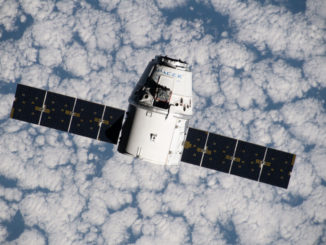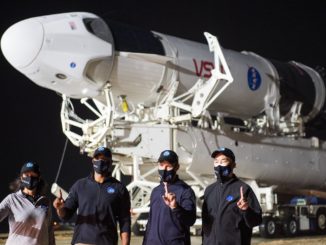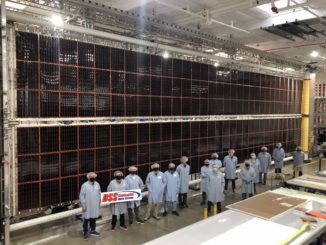
Astronauts Christina Koch and Andrew Morgan floated outside the International Space Station Sunday and completed a 7-hour, 1-minute spacewalk to begin replacing batteries on the far left side of the research outpost’s solar array truss, the first of up to six excursions scheduled before the end of October.
Koch and Morgan suited up for Sunday’s spacewalk inside the space station’s Quest airlock module. Once in their spacesuits, they entered Quest’s crew lock and began depressurizing the airlock compartment. The astronauts switched their spacesuits to battery power at 7:39 a.m. EDT (1139 GMT) to officially mark the start of the spacewalk.
After exiting the Quest airlock, Koch and Morgan gathered tools and moved to the station’s far port-side truss segment, or P6, to begin the battery replacement work.
Six new lithium-ion batteries were delivered to the station Sept. 28 by Japan’s eighth HTV cargo freighter to replace aging nickel-hydrogen batteries on the P6 truss.
The space station’s power system includes eight electrical channels, two on each of the research lab’s solar array modules with wings extending 240 feet (73 meters) tip-to-tip. The P6 truss powers the station’s 2B and 4B electrical channels.
Sunday’s spacewalk was the second in the careers of both Koch and Morgan, and the 219th spacewalk in support of space station assembly and maintenance since 1998.

Each of the four solar array truss segments originally operated with 12 nickel-hydrogen batteries. One of the higher-capacity lithium-ion batteries take the place of two nickel-hydrogen units. By the end of the month, astronauts on five spacewalks will have removed the 12 nickel-hydrogen batteries and installed six upgraded batteries, along with new adapter plates, in their place on the P6 truss.
Before Sunday’s spacewalk, the space station’s robotic arm pulled a cargo pallet from the Japanese HTV supply ship and moved it to a point near the P6 work site. But the P6 truss is outside the reach of the robotic arm, so spacewalkers will have to manually shuttle the old and new batteries between the pallet and the P6 truss work site.
Koch and Morgan worked through the battery tasks more quickly than anticipated Sunday, and mission control in Houston gave the spacewalkers the go-ahead to complete extra tasks, removing and and installing batteries that were originally scheduled for work during a spacewalk Friday, Oct. 11
“It was a fully successful (spacewalk) and more today, as they were able to complete all their primary tasks and several get-ahead tasks, actually getting some batteries swapped out that weren’t supposed to take place until the second spacewalk,” said Dan Huot, the NASA TV commentator for Sunday’s spacewalk.
For Sunday’s spacewalk, Koch was designated EV-1 and wore a spacesuit with red stripes. Morgan, designated EV-2, wore a spacesuit with no markings. Both astronauts wore helmet cameras to help mission control follow along with their progress, with Koch wearing camera No. 11, and Morgan camera No. 18.
Twelve new lithium-ion batteries have been connected on two of the station’s solar array modules over the last few years after deliveries on two previous HTV missions, but the robotic arm was able to reach the work sites for the installation of those batteries on the solar array truss segments closer to the station’s pressurized modules.
“The inboard solar arrays are accessible by the arm, so that allowed the robotic arm to do a lot of the battery changeout,” said Keith Johnson, NASA’s spacewalk officer. “But they couldn’t hook up the electrical connectors, so we had to send out EVA crew members to go do that. With the outboard batteries, the ones that we’re going to do here on the port side, the robotic arm can’t reach.
“So it gets as far as it can go with the exposed pallet, which holds the batteries and the adapter plates,” Johnson said.
“It’s a long way out there, it’s a long translation path. But then the crew members have to go back and forth between this palette and the integrated equipment assembly to do this changeout.”

On Sunday’s spacewalk, the astronauts removed one of the old nickel-hydrogen batteries and transferred it to the HTV cargo pallet mounted on the station truss. Then they retrieved a new lithium-ion battery and installed it on the P6 truss’s integrated equipment assembly, followed by the removal of another nickel-hydrogen battery for mounting on the HTV pallet, which will eventually re-enter the atmosphere and burn up.
“The choreography that the crew members have back and forth is very important because they’re going to be moving a box that’s about 428 pounds (194 kilograms), and taking it off of the pallet and moving it out to the integrated equipment assembly (on the P6 truss),” Johnson said in a press briefing before Sunday’s spacewalk. “And then they’ll take off an old battery, which weighs about 365 pounds (165 kilograms), and bring that back again.”
The battery boxes have no weight in microgravity, but they are still massive and bulky.
“If you imagine your kitchen refrigerator, and you chop your refrigerator in half, that’s about the size of these batteries,” said TJ Creamer, a NASA flight director and former astronaut. “It’s a bit of a volumetric challenge.”
“So it takes two crew members, they handle it between the two of them, and they go very slowly,” Johnson said. “It’s what we call shepherding. They’ll have a hand on it, and one crew member will move a little bit farther along and get in position, and then the following crew member will push the battery forward and hand it over to them. And so it’s kind of a shuffle back and forth,” Johnson said. “It’s it’s kind of interesting going back and forth, and it takes about an EVA to do a pair of batteries. And so that’s why you’ll see us doing this over a stream of five days because we get some done, and we hope to leave it in a good state at the end of each of these days. And then we come out the next EVA and pick up where we left off.”
The spacewalkers carefully maneuvered the batteries along the truss from the HTV cargo pallet to the P6 integrated equipment assembly.
“I have the battery,” Morgan radioed during one of the battery hand-offs as they astronauts inchwormed along the truss.
“I see that. You have the battery,” Koch replied.
Koch and Morgan completed the original tasks for Sunday’s spacewalk with time to spare, so they proceeded with the removal of a third nickel-hydrogen battery and the installation of a second lithium-ion unit on the P6 truss. As planned, they connected one of the lithium-ion batteries to the space station’s electrical network.
The astronauts wrapped up their work and headed back to the Quest airlock to complete the spacewalk. After closing the hatch to the airlock, pressurization of the Quest crew lock began at 2:40 p.m. EDT (1840 GMT) to mark the official end of the excursion at 7 hours, 1 minute.
“On behalf of the P6 battery EVA ground team, we’d like to thank you for your awesome work today,” radioed astronaut Stephanie Wilson from mission control in Houston. “We have made great progress in upgrading the batteries on the (channel) 2B side. Nice job.”
NASA is planning four more spacewalks with Koch, Morgan, flight engineer Jessica Meir and station commander Luca Parmitano on Oct. 11, Oct. 16, Oct. 21, and Oct. 25 to complete the battery changeouts.
Koch and Morgan are again assigned to the next spacewalk on Oct. 11.
A Russian spacewalk is scheduled for Oct. 31 to bring the total October EVA tally to six at the space station.
Once the battery tasks are complete, NASA plans another five spacewalks in November and December to repair the space station’s Alpha Magnetic Spectrometer particle physics experiment. The schedule makes the next two months the busiest for spacewalks at the space station since 2011, when NASA retired the space shuttle and declared the station’s assembly complete.
A final set of six new lithium-ion batteries will be delivered on Japan’s next HTV resupply mission in May 2020, followed by a similar series of spacewalks to install them.
Email the author.
Follow Stephen Clark on Twitter: @StephenClark1.



